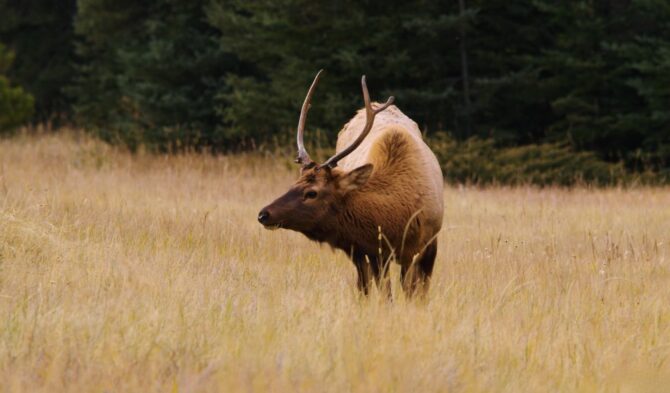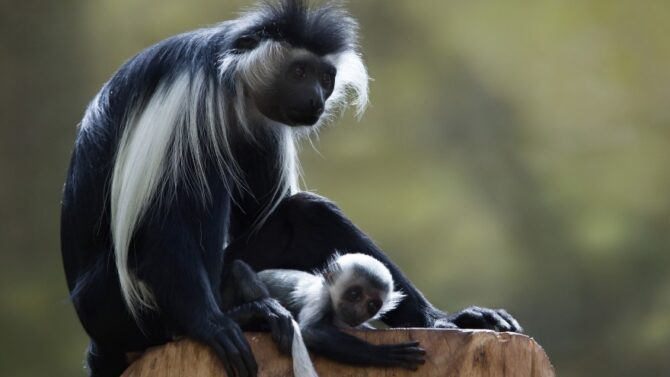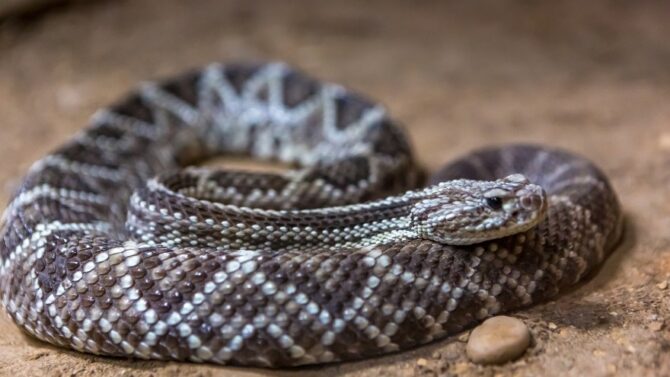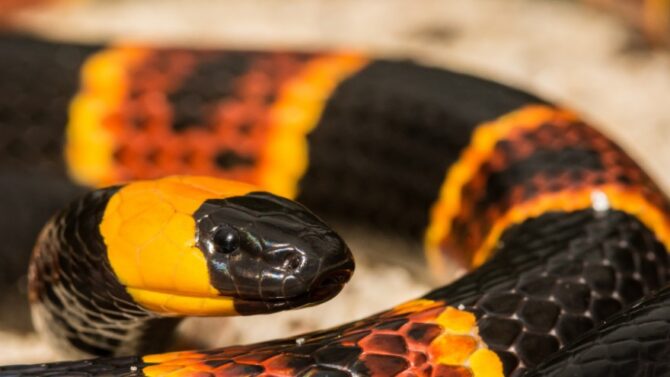Wildlife In North America – Native Animals In North America
North America is home to many animals, thanks to its diverse range of ecosystems that house such a wide variety.
The Tongass national forest, Chihuahuan Desert, Lake Tahoe, Mississippi River, Denali Mountain, Town Hill, and Yosemite Valley are among the world’s most popular landforms.
However, they are only some of North America’s major landform features, providing shelter and other crucial demands to various animal species, from mammals, birds, reptiles, and amphibians.
While a moose might live in fear of the wolf and bear, it shares the same continent with them; the American desert hare that inhabits the Mojave Desert also shares North America with the Okefenokee Swamp’s alligator.
Read on for a broader knowledge of North America’s wildlife.
Wildlife In North America: Popular Native Animals in North America
North America is home to several wildlife species. Still, some animals are more popular thanks to their population, in-culture significance, nearness to urban areas, and the number of tourists they attract annually.
While some people may not know that spider monkeys and eastern indigo snakes reside in North America, they know the American bison because it’s the United States’ national animal.
People are familiar with the deer because West Virginia, Montana, and Pennsylvania have high deer collision rates. Here are North America’s top animals.
American Bison
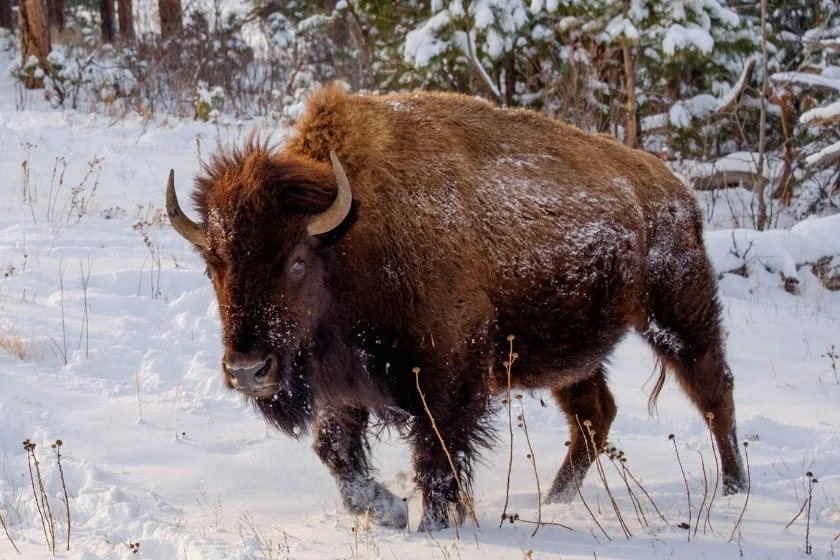
Scientific name: Bison bison
The American bison is one of the most popular wildlife in North America, thanks to its large size and cultural significance as the United States national animal.
This shaggy-coated beast is North America’s largest mammal, weighing up to 2,000 pounds and standing at six feet. Its existence is more pronounced in the United States wildlife, where it has lived in Yellowstone National Park since prehistoric times.
While it is a big and fast animal, the American bison has no interest in eating animals; it is a herbivore, with grasses and sedges comprising its primary diet.
The American bison range initially covered the grasslands from Alaska to the Gulf of Mexico; however, the animal almost faded into extinction in the nineteenth century, shrinking its geographical range.
An estimated 15,000 bison individuals exist in the wild, but between 400,000 and 500,000 live in conservation herds.
North American Beaver
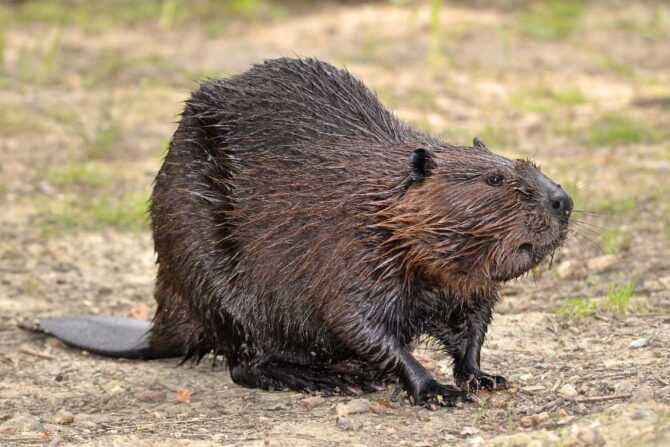
Scientific name: Castor canadensis
The North American beaver used to inhabit every nook and cranny between the south of the arctic tundra and northern Mexico’s deserts before experiencing a near-extirpation as North Americans explored its fur in the textile industry.
Now, the rodent calls the continent’s boreal and temperate ecoregions home but gains more cultural significance as Canada’s national wildlife symbol and Oregon and New York’s official state mammal.
Eagle
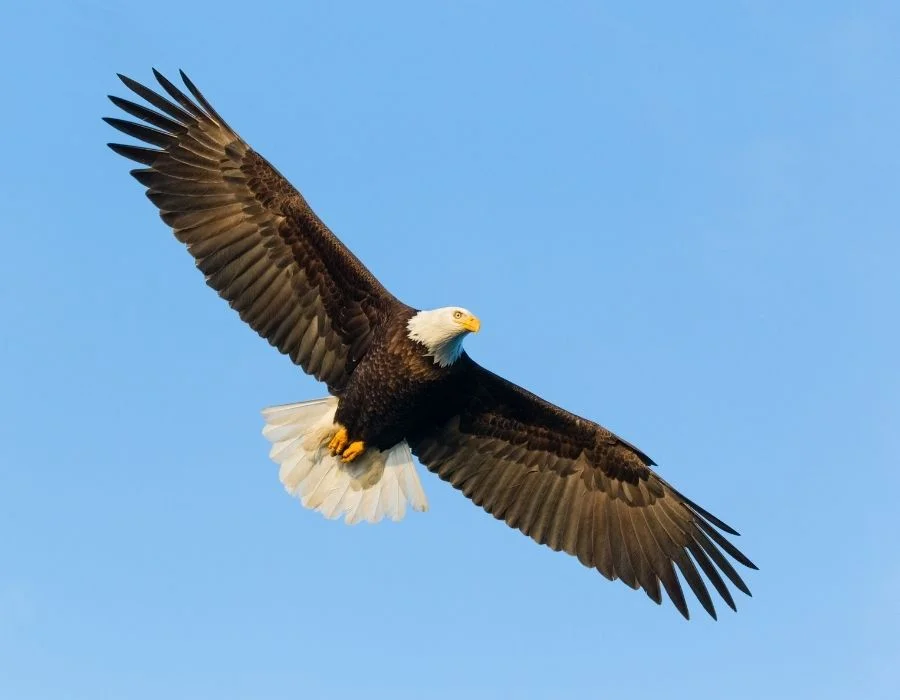
Scientific name: Accipitridae
The large bird of prey is unsurprisingly among North America’s top wildlife, with jaw-dropping wingspans over 2.5 meters. While there are over sixty eagle species, only two are native to North America, the bald and golden eagles.
The white-tailed and Steller’s sea eagles might fly over the continent but are not endemic to it. The bald and golden eagles inhabit and fly over territories from the Northern Mexican border to Canada and Alaska.
The eagles’ presence in Mexico accounts for its cultural significance as the country’s national symbol.
American Crocodile

Scientific name: Crocodylus acutus
While the American crocodile has little cultural significance, it sits among North America’s top wildlife as one of the largest crocodile species and the most populous crocodile species in the Americas.
The large reptile, reaching twenty feet, is reputed for its salinity preference even though it survives in freshwater habitats; it primarily inhabits brackish lakes and mangrove swamps around Mexico and South Florida, and the Dominican Republic.
Cougar
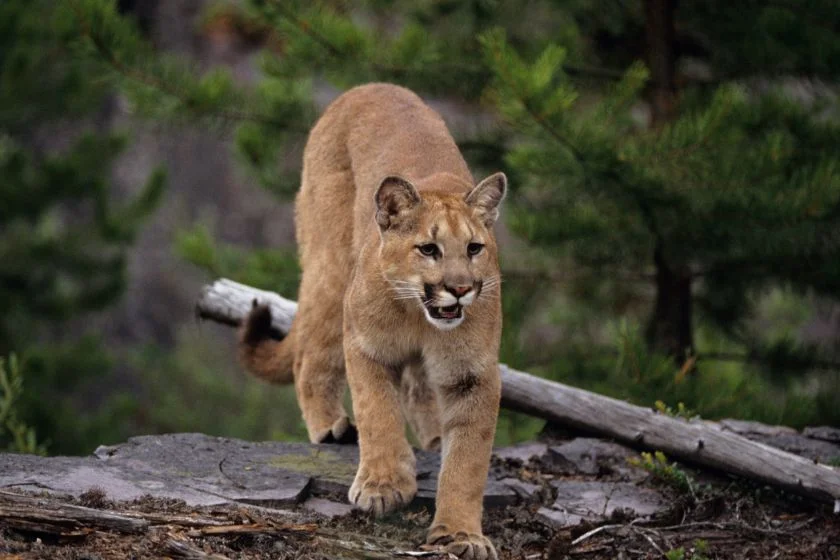
Scientific name: Puma concolor
The cougar once roamed Central and South America; however, human activities, including hunting, have reduced the large ambush predator population to isolated areas in North America.
The cougar is notably solitary but can survive in all forest types, open areas with sparse vegetation, lowlands, and mountainous deserts.
Mexico, Southern Florida, Western U.S. wilderness areas, and Southwestern Canada are North American locations that record cougar sightings.
Hare
Scientific name: Lepus
Hare species are native to North America, Africa, and Eurasia; these small mammals are herbivores and live solitarily or in pairs.
They inhabit most areas in the United States’ western half and Mexico, where they can find dunes, desert scrublands, farmlands, and prairies.
Hares may be small but appear in cities with suitable habitats, making them one of the country’s most popular wildlife.
Common Raccoon
Scientific name: Procyon lotor
The masked, ring-tailed omnivore is native to North America, primarily favoring deciduous and mixed forests. Raccoons can also survive in coastal marshes, mountainous, and urban areas due to their adaptability.
Raccoons are famed for their intelligence and regular appearance in urban areas. Raccoons roam most parts of the United States, Canada, and Mexico.
Polar Bear
Scientific name: Ursus maritimus
One can find any bear species across North America, but polar bears occupy a narrow ecosystem.
The polar bear has distinct body features modified for cold climates; little wonder it moves across the snow, ice, and open water to hunt arctic foxes and seals across Alaska, Northwestern Canada, and Greenland.
Moose
Scientific name: Alces alces
The moose differs from other deer species in social behavior and appearance. One can quickly identify a moose with its thickened skin and dense, heat-retaining coat, while bull moose have large open-hand-shaped antlers.
The moose’s cold-adapted modification, reliance on cover from predators, and diet requirement for young trees, pond grasses, and shrubs make North America’s cold region most suitable for survival.
Thus, the moose range includes the United States’ northern regions from Maine to Washington, Alaska, and throughout Canada.
Endemic North American Animals
Some species exist everywhere, while others are ecologically distributed in specific locations. Several animal species live in North America, but the following are endemic to the continent.
Mohave Ground Squirrel
Scientific name: Xerospermophilus mohavensis
Conservation status: Near Threatened
The Mohave ground squirrel is a small rodent, measuring about nine inches. Small size is not the only thing that defines the Mohave ground squirrel.
It is endemic to North America, having one of the smallest geographic ranges of the continent’s ground squirrels, the western Mojave desert.
Gila Monster
Scientific name: Heloderma suspectum
Conservation status: Near Threatened
This lizard has a name and reputation that sends shivers down the spine of North Americans, prompting them to kill it despite Arizona state awarding it legal protection.
Gila monsters are sluggish but venomous, with painful bites due to their sharp and interlocking teeth.
Gila monsters, the largest extant lizard species endemic to North America, growing over a foot long, once roamed the Gila River Basin in New Mexico and Arizona.
Gila Monsters remain in New Mexico and Arizona, with breeding populations in the other Southwestern United States and Mexico.
They reside in deserts, scrublands, and oak woodlands, favoring shelter in thickets, burrows, and under rocks. Sadly, Gila monsters are flagged “near threatened” by the International Union for Conservation of Nature (IUCN).
Utah Prairie Dog
Scientific name: Cynomys parvidens
Conservation status: Endangered
The Utah prairie dog is a misnomer for a rodent. It is a prairie dog species, the smallest of the rodent, native to Utah.
The multicolored prairie dog is primarily herbivorous, favoring marshy places with abundant herbaceous plants. The Utah prairie dog is endangered, with a few individuals in southern Utah.
Black-Footed Ferret
Scientific name: Mustela nigripes
Conservation status: Endangered
The black-footed ferret is a weasel similar to the European and Asian steppe polecats. All its names tell about its appearance, geographical distribution, or prey.
The black-footed ferret is a black-footed polecat that differs from its European and Asian cousins by a greater contrast between its dark limbs and pale body, outlined with dark fur on its paws, tail, ears, and parts of its face.
Also called the prairie dog hunter or American polecat, the black-footed ferret once roamed the intermountain prairies and grasslands of Northern Mexico and Southern Canada but currently inhabits such habitats in Arizona, Montana, South Dakota, and Wyoming.
Prairie dogs made up the black-footed ferret’s favorite item seven; little wonder they thrived in the North American Great Plains, where prairie dog colonies flocked.
Giant Kangaroo Rat
Scientific name: Dipodomys ingens
Conservation status: Endangered
Kangaroos are endemic to Australia, but one cannot say the same for the giant kangaroo rat; the rodent is rather endemic to the North American city of California, U.S.A.
The giant kangaroo rat inhabits dry, sandy grasslands, where it can dig burrows in loose soil. Sadly, this rat suffers what other species with a small geographical range suffer — the sad reality of possible extinction.
The giant kangaroo rat occupies less than two percent of its original range, with small populations in isolated areas within California.
Gopher Tortoise
Scientific name: Gopherus polyphemus
Conservation status: Vulnerable
The gopher tortoise is the only tortoise endemic to North America, digging shelter-providing burrows for at least 360 other species in the well-drained, sandy soils of the southeastern United States.
This large terrestrial reptile is an opportunistic grazer and herbivore scavenger favoring dry prairies, longleaf pine sandhills, pine flatwoods, scrubs, and coastal dunes.
The gopher tortoise faces human predation and habitat destruction, and the IUCN considers it “Vulnerable.” However, it holds cultural significance in its native region as Florida’s state tortoise and Georgia’s official state reptile.
Most Dangerous Animals in North American
North America’s wildlife is satisfying, but some animals on the continent are notorious for not being so friendly.
Most animals have a defense mechanism, and they put them to good use if they feel threatened. The American bison, cougar, and raccoon rank among the most dangerous animals in some American states.
Still, insects like the brown recluse spider and reptiles like snakes and alligators are some deadlier animals you do not want to encounter. Here are some of North America’s most dangerous animals.
Deer
Scientific name: Cervidae
You will most likely find a deer, particularly the white-tailed deer, through fields and forests or giddily crossing roads in several areas within the United States.
Deer-vehicle collisions result in about two hundred deaths and $1.1 billion of property damage annually.
Moreover, direct contact with deer can be ghastly when attempting to stop them from trampling and defecating on gardens and landscapes. According to reports, an average of 65,000 deer-vehicle collisions occur in New York annually.1
Bear
Scientific name: Ursus
Three bear species, the brown, black, and polar bears, reside in North America. The black bear (Ursus americanus) is the most common, found in almost all Canadian provinces and territories and forty of the fifty American states.
The grizzly or brown bear (Ursus arctos) inhabits Canada’s British Columbia, Alberta, the Yukon and Northwest territories, and America’s Wyoming, Montana, Idaho, and Washington.
Although these species are big, they are agile, fast, incredible climbers, and fantastic swimmers. Black bears can deliver up to 800 PSI of bite force and a swipe force reaching 560 pounds, while brown or grizzly bears have bites reaching 975 PSI.
The polar bear (Ursus maritimus) is also dangerous despite occupying a narrow ecosystem across the snow, ice, and open water of Alaska, Northwestern Canada, and Greenland. Polar bears can generate a bite force of over a thousand pounds per square inch.
Western Rattlesnake
Scientific name: Crotalus oreganus
The western rattlesnake may face habitat destruction and predation but will fight back by striking in defense.
The western rattlesnake is reclusive and avoids humans despite being the only venomous snake in British Columbia and the only snake in Oregon that poses a threat to humans.2
The snake inhabits the woodlands, desert scrubs, and temperate grasslands in Canada, Mexico, and the United States.
The western rattlesnake reaches five feet even though it is no longer than two feet at birth. Fortunately, death from western rattlesnake bites in North America is rare as they mostly dash ‘dry bites,’ injecting no venom to scare humans off.
However, the western rattlesnake can eject between 250 and 350 milligrams of venom on average, with a maximum of 700 mg to 800 mg.
Gray Wolves
Scientific name: Canis lupus
The gray wolf subspecies exist mostly in remote areas and wilderness in Canada, Alaska, Greenland, and the Northern United States.
These animals are menacing, measuring over five feet in length and reaching two feet, seven inches in height, with powerful jaws and teeth and powerful bodies. Incidents involving wolves in North America are not uncommon.
While only nine fatal attacks have been reported since the twentieth century, over thirty non-fatal attacks have occurred in the twenty-first century. Thus, we cannot sweep the potential threats of wolves under the carpet.
American Alligator
Scientific name: Alligator mississippiensis
The American alligator is among South Carolina’s most dangerous species, and its fearsome reputation has spread across North America.
One does not need someone else to point out the dangers of all alligator species; the American alligator is no different.
The American alligator is native to two North American countries, largely in the United States, with a small population in Mexico, where they inhabit slow-moving rivers, marshes, swamps, and lakes.
While it is a keystone species because of the small ponds it creates, helping aquatic organisms during the dry season, it is not human-friendly.
Endangered North American Animals
North America houses many species, but not all have a healthy breeding population. While some thrive and record a viral population increase, others may fade into extinction in the next few decades.
Here are some of the continent’s endangered animals.
Red Wolf
Scientific name: Canis rufus
Conservation Status: Critically Endangered
The red wolf differs from its gray cousins due to its more reddish and sparsely furred appearance and once roamed a large part of North America across the United States, Canada, and Mexico.
Sadly, it is now a critically endangered species with an estimated thirty-five or fewer exclusive to eastern North Carolina in forests, swamps, and coastal prairies.3
Like other canines, red wolves are carnivores, hunting raccoons, white-tailed deer, and small mammals like mice and rabbits.
Pygmy Raccoon
Scientific name: Procyon pygmaeus
Conservation Status: Critically Endangered
The pygmy raccoon is distinct from the common raccoon in size and overall appearance, being smaller with a broader black throat band, rounder snout, reduced teeth, and golden yellow tail.
These are the only physical traits that differentiate the pygmy raccoon from the common raccoon, as both species look very similar.
The pygmy raccoon has a small geographic range narrowed to Cozumel Island off the coast of the Yucatan Peninsula, Mexico; such a small geographic range contributes to the raccoon’s declining population, with an estimated 250-300 pygmy raccoons remaining in the wild.
The pygmy raccoon can survive in a range of habitats despite its small population. However, it primarily inhibits Cozumel Island’s mangrove forests and sandy wetlands.
California Condor
Scientific name: Gymnogyps californianus
Conservation Status: Critically Endangered
The California condor, North America’s largest land bird, is a largely bald vulture endemic to the continent. It lives in coniferous forests, rocky shrublands, and oak savannas, occupying cliffs or large trees, which it uses as nesting sites.
While it is currently facing extinction, this bird was popular among native Americans, serving as an important symbol and
Mythological subject. The United States has a conservation process, possibly one of the country’s most expensive species conservation projects, costing over $35 million and averaging $2 million annually in 2007.
The California condor became extinct in the wild in 1987; breeding populations now exist in the wild following the reintroduction of captured individuals to the coastal mountains of California, northern Arizona, southern Utah, and northern Baja California in Mexico.
Native Birds in North America
North America’s avifauna runs into thousands, with over 1,200 species in the United States only.
Here are some of the continent’s warm-blooded vertebrates with beaked jaws, lightweight skeletons, and feather-covered bodies.
Roadrunners
Scientific Name: Geococcyx
There are two species of the roadrunner, the greater and lesser roadrunner. In Mexico, along the Pacific Ocean, roadrunners can be found all the way south to Guatemala, El Salvador, and Honduras.
Also, in Central Mexico, from Hidalgo to Tamaulipas and New Mexico. They are common in southern New Mexico and the Pecos and Rio Grande river valleys.
Along with northern Central America and a disjointed range in the northern Yucatán Peninsula, roadrunners breed in southern Mexico, north into the western edge of the Sierra Madre Occidental range, and northern Central America.
These birds live in open places with prickly bushes and brush. They can even survive on cultivated terrains like cornfields and henequen.
Cranes
Scientific Name: Gruide
These birds are known for their long beak, neck, and legs. There are 15 species of this bird, with the sand hills being the most prevalent. Sandhill cranes use New Mexico as a significant migration route and wintering area.
This sandhill crane’s subspecies builds its nests in the Rocky Mountains. Lesser sandhill cranes winter mostly in Bitter Lakes National Wildlife Refuge, which lies in the Pecos Valley in New Mexico.
Near the city of Portales and the Grulla NWR in Roosevelt County, there are various other areas with substantial populations.
Sparrows
Scientific Name: Passer
Emberizidae, Estrildidae, and Passeridae are the three families into which sparrows are divided. In Canada, the family Emberizidae has about 25 species. Most species of sparrow have a similar size.
One can find house sparrows, in the family Passeridae, across all provinces and major cities in Canada. The southern portions of each territory, including Yellowknife and Whitehorse, are also home to them.
In Canada, every species of sparrow is somewhat migratory. American tree sparrows (Spizella arborea) spend the winter in southern Canada and the northern United States and build their nests on Subarctic willow scrub.
Harris’s sparrow breeds are also exclusive to northern Canada.
Bald Eagles
Scientific Name: Haliaeetus leucocephalus
This bird spots a dark brown body with a head, neck, and tail in dazzling white. The majority of the bald eagle breeding population in Canada is concentrated in British Columbia, particularly near the Pacific coast.
The woods of Alberta, Saskatchewan, Manitoba, and northwest Ontario supports thriving breeding bald eagle populations.
Bald eagles will occasionally gather during the winter months near bodies of open water, such as the St. Lawrence River, by non-freezing water bodies in some parts of southern Canada or areas where they can discover dead animals.
Red-tailed hawks
Scientific Name: Buteo jamaicensis
This bird of prey can be seen in North America as it is all too common; it is a large bird with a reddish brown tail and expansive wings. It inhabits terrains offering wide hunting spaces and high perches.
Red-tails from the north may travel rather far south, but many of them, especially adults in the middle or south, are year-round residents.
The breeding range of the red-tailed hawk encompasses all of North America, from central Alaska south through Mexico and into Central America.
While many northern birds migrate south in the winter, some red-tailed hawks remain in Minnesota, United States, all year.
Great Blue Herons
Scientific Name: Ardea herodias
Great Blue Herons can survive in almost any marsh habitat in North America. They are seldom found far from water, characterized by their lengthy legs, necks, and beak.
These enormous grey-blue birds, during winter, migrate south of the northern limit of their breeding area, with some going as far south as the Caribbean.
However, during summer, one can find them in Alaska and the southern Canadian provinces.
Ring-Necked Pheasants
Scientific Name: Phasianus colchicus
Ring-necked pheasants are fairly long and chubby, with a small head, long neck, and long tail. This attractive bird resides more on the ground than in the air, as it can only cover short distances while airborne.
One can spot them on the sides of country roads, in overgrown or freshly harvested fields, brushy regions, and hedgerows.
They were introduced to North America from Asia, and since then, the Central U.S states have held the largest population of these pheasants.
Native Snakes in North America
About 150 venomous and non-venomous snake species call North America home. While some snakes are quite deadly, over ninety percent of these limbless reptiles are non-venomous, each species contributing to the biota.4
Timber Rattlesnake
Scientific Name: Crotalus horridus
The Timber Rattlesnake is a poisonous pit viper in North America’s mountainous forests, agricultural fields, hilly forests, hardwood forests, lowland cane thickets, pine forests, swamps, and river floodplains.
This rattlesnake is highly venomous, with an extremely powerful, hemotoxic venom enough to kill a human. Timber Rattlesnakes prey on rodents, birds, lizards, and amphibians.
Massasauga
Scientific Name: Sistrurus catenatus
The Massasauga is a venomous rattlesnake species that you must be extremely cautious around, as its bites can result in extreme health conditions.
It’s so deadly that coagulopathy (bleeding disorder) may occur after anti-venom administration due to the venom’s complexity.
The snake inhabits wetlands, prairies, swamps, woodlands, tree roots, and rock crevices in the northern midwest United States and Ontario, Canada.
Copperhead
Scientific Name: Agkistrodon contortrix
The Copperhead is an attractive snake with a bronze-hued head, reddish-tan, copper-colored body (where it undoubtedly gets its name from), and hourglass-shaped stripes on its back.
Deciduous forests, mixed woodlands, rock outcroppings, ledges, swampy regions, dens, and limestone crevices in eastern North America houses the Copperhead.
One can find the Copperhead in more than half of the United States and in Chihuahua and Coahuila, Mexico. The Copperhead ejects a hemolytic venom that breaks down red blood cells.
While it is amongst the least potent pit vipers, its bites can be severe, resulting in nausea, vomiting, diarrhea, or labored breathing.
Milk Snake
Scientific Name: Lampropeltis triangulum
With its smooth and shiny scales, the milk snake is one of North America’s non-venomous snakes, slithering within the North American countries of the United States and Canada.
The band-color-patterned snake primarily inhabits forested regions; however, it can also occupy swamps, farmland, prairie, dunes/beaches, and rocky slopes.
Common Garter Snake
Scientific Name: Thamnophis sirtalis
The common garter snake is a garter snake species endemic to North America, occurring at altitudes from sea level to mountains in the United States and Canada.
It inhabits a wide range of near-water habitats, including wetlands, meadows, streams, marshes, and ponds.
Amphibians and earthworms comprise the common garter snake’s primary diet, but small birds, fish, and rodents can also make the food chart.
Native Fish in North America
The Mississippi, Río Sonora, Yukon River, and other North American waters are home to various freshwater fishes.
The Pacific, Arctic, and Atlantic oceans and the Caribbean Sea provide the requirements for several marine species.
Let’s consider some fish species in North America.
Agujon Needlefish
Scientific Name: Tylosurus acus
The Agujon Needlefish has a long, slender, upcurved beak, similar to other Needlefish species, and an elongated body.
The Atlantic Ocean flowing through eastern North America is the most suitable abode for the Agujon needlefish.
Its presence in coastal waters makes it available along the shores of the Appalachian Mountains.
Albacore Tuna
Scientific Name: Thunnus alalunga
This species prefers tropical, subtropical, and temperate marine waters. This encompasses the warmer waters of the Pacific and the Atlantic Oceans on both coasts of the United States.
They can cover more than 100 kilometers because they are a highly migratory species.
Alligator Gar
Scientific Name: Atractosteus spatula
The Alligator Gar’s long, slender, cylindrical bodies, long snouts, and diamond-shaped interlocking (ganoid) scales make it distinct from other freshwater species.
From the Econfina River in Florida to Veracruz, Mexico, the Gulf coastal plain is home to alligator gar. The historic range in the Mississippi River basin continues upwards to the Missouri and Ohio rivers’ lower reaches.
Big rivers, reservoirs, and coastal bays may also house the alligator gar in Texas.
American Angler
Scientific Name: Lophius americanus
Devil-fish, wide-gape, or all-mouth are just some of the American Angler’s names from the family Lophiidae. The American Angler is a flat, toothy fish with sharp spines on its head and a very wide mouth.
It is indigenous to North America’s eastern shore. The American anglerfish is widespread in the western Atlantic from Newfoundland and Quebec to northern Florida.
Still, it is more prevalent in the more northern reaches of its range, north of Cape Hatteras. One can find the American Anglerfish in waters at least 1,200 feet deep.
American Eel
Scientific Name: Anguilla rostrata
With a snake-like appearance, this fish has a whitish belly and a body that is greenish, yellowish-brown, or blackish.
Although most eels spend most of their life in freshwater lakes and rivers, others continue to dwell close to the coast in brackish water, a mixture of salt and freshwater.
Eels will hide out in the mud at the bottom of bays when it is winter in brackish or salt water, but nothing is known about the eels’ habitat in freshwater.
When it is time to spawn, they return to the Sargasso Sea, an area in the Atlantic Ocean along North America’s east coast.
American Gizzard Shad
Scientific Name: Dorosoma cepedianum
This gizzard shad is not to be confused with the thread in shad; a characteristic that differentiates them is based on how much the upper jaw extends from the lower jaw for the gizzard shad.
Gizzard shads are most prevalent in large rivers and reservoirs, especially in Texas’s main streams and reservoirs. They are often seen in large schools.
Native to eastern North America, the gizzard shad’s range stretches into North Dakota on the west. It includes the Saint Lawrence River and the Great Lakes (excluding Lake Superior) in the north.
One can find the gizzard shad in Alaska and far south in eastern Mexico.
American Yellow Perch
Scientific Name: Perca flavescens
One of the most undersized members of the Percidae family of perches is the American Yellow Perch.
They inhabit rivers, lakes, ponds, and creek pools, favoring the rivers that flow into the Atlantic and Arctic Oceans, the Great Lakes, the Mississippi River basin, the bulk of the northeastern United States, and some regions of Canada.
In the winter, perch frequently migrate to deeper waters.
Places to Watch Wildlife in North America
Are you gassed to visit the United States, Canada, Mexico, or any other North American country after reading about the continent’s fauna?
If so, below are some incredible destinations where you are sure to enjoy the extraordinary sights of untamed nature and wildlife.
- Cape Breton Highlands National Park, Canada
- Jasper National Park, Canada
- Northeast Greenland National Park, Greenland
- Sian Ka’an Biosphere Reserve, Yucatan Peninsula, Mexico
- Banco Chinchorro, Quintana Roo, Mexico
- Denali National Park, Alaska, United States
- Glacier National Park, Montana, United States
- Saguaro National Park, Arizona, United States
- Yellowstone National Park, United States
Frequently Asked Questions (FAQs)
What kind of wildlife does North America have?
North America houses many of the world’s most popular wildlife, including bears, cougars, deer, moose, bison, bald eagles, and raccoons.
What habitats in Africa support wildlife?
Forests, wetlands, prairies, deserts, deserts, scrublands, and woodlands in North America have the perfect climate and terrains to support specific wildlife.
What African country has the most wildlife?
One can find wildlife in most parts of Africa, but the United States has the continent’s largest wildlife population thanks to its diverse range of habitats.
What is North America’s deadliest Animal?
The brown beat is North America’s deadliest animal, according to a 2021 article on U.S.A Today. The brown bear (Ursus arctos) inhabits Canada’s British Columbia, Alberta, the Yukon and Northwest territories, and America’s Wyoming, Montana, Idaho, and Washington. Although these species are big, they are agile, fast, incredible climbers, and fantastic swimmers. Brown bears have bites generating up to 975 PSI.
Wrap Up
North America, the world’s third-largest continent by area is blessed with a rich and diverse range of untamed nature, from scenic landscapes to exotic wildlife exclusive to the continent.
As the creatures continue to thrive in their various settings, we should take advantage of all avenues to support conservation efforts to ensure the continuity of these species.
Latest North American Wildlife Articles
References & Notes
- Cline S. (2018). A deer is struck every 8 minutes in NY — and it’s worse in the fall. Times Union.
- Western Rattlesnake. [pdf] Province of British Columbia Ministry of Environment, Lands, and Parks.
- Red wolves. National Geographic.
- Snakes. Internet Center for Wildlife Damage Management.
